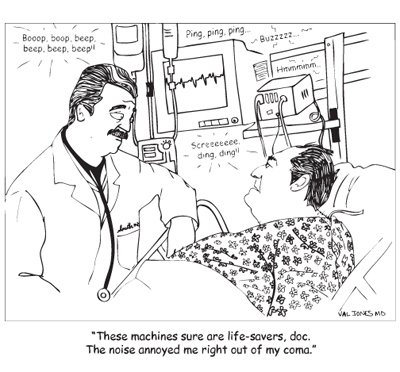February 25th, 2011 by Peggy Polaneczky, M.D. in Opinion, True Stories
No Comments »

A pathologist uses the EMR to find out just a little more about the patient whose cerebro-spinal fluid she has under her microscope — and changes her diagnosis:
This patient had a diagnosis of plasma cell myeloma with recent acute mental status changes. So the lone plasma cell or two I was seeing, among the lymphs and monos, could indicate leptomeningeal spread of the patient’s disease process. I reversed the tech diagnosis to atypical and added a lengthy comment – unfortunately there weren’t enough cells to attempt flow cytometry to assess for clonality of the plasma cells to cinch the diagnosis. But with the information in the EMR I was able to get a more holistic picture on a couple of cells and provide better care for the patient. I cringe to wonder if I might have blown them off as lymphs without my crutch.
The much-hoped-for improvement in quality due to the adoption of EMRs has been elusive to date, so anecdotal experiences like this will be important evidence to consider in judging the impact of the EMR on healthcare outcomes.
Kudos to pathologist Gizabeth Shyner, who writes over at Mothers in Medicine and her own blog, Methodical Madness, for “thinking outside the box.”
*This blog post was originally published at The Blog That Ate Manhattan*
November 15th, 2010 by GruntDoc in Better Health Network, Health Policy, Opinion
No Comments »

From a recent post of the Retired Doc’s Thoughts blog entitled “What Are the Plans Of Don Berwick’s ‘Leaders With Plans?’“:
“I wonder which is worse: A medical leader recommending price controls out of ignorance of basic economics or being aware of the likely outcomes and mak[ing] that recommendation anyway?”
Wow. I’m speechless. Thanks to Retired Doc for getting this out in a cogent summary.
*This blog post was originally published at GruntDoc*
October 6th, 2010 by StevenWilkinsMPH in Better Health Network, Health Tips, Research, True Stories
No Comments »

A 69-year-old woman who swims in my master program came back to the pool after a total knee replacement. I asked her how she was doing. She said she is still in a lot of pain because of her physical therapy. She said that her physical therapist was disappointed that she still was still unable to achieve full flexion of 120 degrees. Why 120 degrees? Did you set that goal I asked her? “No,” she said, “the therapist did.”
She went on to tell how she already had more range of motion in her knee than she did before the surgery. My friend was quite satisfied with her progress and wanted to stop physical therapy. The pain from the PT was worse than anything she had experienced before the knee replacement. I knew she and her 80-year-old boy friend were going on a cruise and she didn’t want to still be hobbling around.
It turns out that patients and physicians disagree on quite a few things. We hear a lot about patient-centered care. You know, that’s where the provider is supposed to consider the patient’s needs, preferences, and perspective when diagnosing and treating health problems. But medicine is still very provider-centered. Read more »
*This blog post was originally published at Mind The Gap*
July 12th, 2010 by BarbaraFicarraRN in Better Health Network, Health Policy, Opinion
No Comments »

From KevinMD’s medical blog, guest post by Toni Brayer, M.D., shares a story where a team approach in medicine is critical for quality patient care.
Dr. Brayer writes:
“Medicine is a team sport and it is only when the team is humming and everyone is working together that patients can have good outcomes. Hospital errors, medication errors, poor communication between doctors and nurses are prevented by adherence to protocols that everyone follows. It takes laser focus, measuring outcomes and a great deal of hard work to ensure everyone is pulling together in a hospital. The fact that these bedside nurses take the time to work on error reduction and patient safety is really amazing. Have you seen how hard nurses work? My hat is off to these dedicated caregivers.”
Dr. Brayer is exactly right when she writes “medicine is a team sport.” Read more »
*This blog post was originally published at Health in 30*
April 26th, 2009 by EvanFalchukJD in Better Health Network, Health Policy
3 Comments »
Our survey of employer attitudes about health benefits told us a lot about what employers are doing, and what they want to stop doing. Here are 5 things employers want to stop doing:
1. Stop paying for bad employee lifestyles. Bad lifestyle choices are big drivers of expense. Our study shows that employers want to stop being solely responsible for those costs. More than half (54%) are adopting programs that use incentives — and penalties — to encourage employees to take responsibility for their health. A study released last week by Watson Wyatt showed similar results.
2. Stop expecting health plans to deliver customized programs. Health plan offerings are popular — there is a nearly 90% adoption rate for core health plan services. But employers increasingly turn to outside vendors for customized programs to fix bad employee health habits. Health plans are looked to for value-based insurance designs, with 40% of employers looking to implement VBID or similar programs.
3. Stop paying for programs that don’t work. Fifty-five percent of employers said they were reducing the number of health benefits they offer or focusing on those with a proven ROI. With 59% saying cost savings are their top priority, it makes sense that they cut costs where they don’t see savings.
4. Stop confusing employees with too many benefit offerings. Employers have in place 10 or more distinct health benefits, with 60% identifying at least five major programs (EAPs, nurse help lines, health coaching, wellness, etc). Employers want to implement a single point of contact to navigate their programs, with adoption rates of these services expected to triple in the next 2 years.
5. Stop thinking bad medical outcomes are because of bad luck. Sixty-five percent of employers said their employees struggle with making the right treatment decisions when sick. Thirty-five percent said making sure their employees have better quality care was a high priority, with 38% saying they wanted to do more to empower employees to make good health care decisions.
*This blog post was originally published at the See First blog.*














